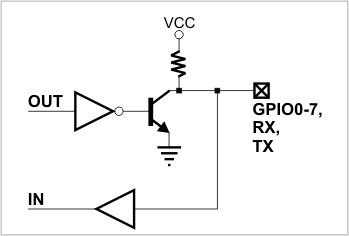Serial Port and General-Purpose I/O Lines
The EM500 has eight general-purpose I/O (GPIO) lines GPIO0~GPIO7 grouped into a single 8-bit GPIO port, plus one serial port.
GPIO0 and GPIO1 double as interrupt inputs INT0 and INT1.
The serial port has four I/O lines: RX, TX, CTS, and RTS. The TX and RX lines belong exclusively to the serial port and are separate from the GPIO lines. The CTS and RTS lines do not exist independently. Rather, either GPIO0/INT0 or GPIO1/INT1 can be selected to serve as the CTS line, while any of the GPIO0~GPIO7 can be selected to serve as the RTS line.
The serial port of the EM500 can work in one of the three modes: UART, Wiegand, or clock/data. TX, RX, CTS, and CTS lines have different names and functions in the Wiegand and clock/data modes. Serial port operation is described in detail in the documentation for the ser. object. Additionally, see the EM500 platform documentation.
In total, the EM500 has ten I/O lines (GPIO0~GPIO7, TX, RX). The simplified structure of one such I/O line is shown in the circuit diagram below. All lines are "quasi-bidirectional" and can be viewed as open collector outputs with weak pull-up resistors. There is no explicit direction control. To "measure" an external signal applied to a GPIO line, first set the line to HIGH, then read the state of the pin. It is OK to drive the pin LOW externally when the pin outputs HIGH internally.
Each I/O line has a weak pull-up resistor that prevents the line from floating when the output transistor is closed. All I/O lines are 3.3V, CMOS, and 5V-tolerant. The maximum load current for each line is 10mA.

I/O line control is described in detail in the documentation for the io. object.
